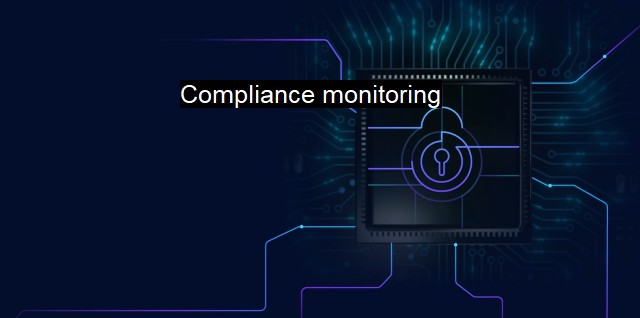What is Compliance monitoring?
The Importance of Cybersecurity Compliance Monitoring: Ensuring Adherence to Security Policies and Protecting Sensitive Information from Cybercrime
Compliance monitoring in cybersecurity and antivirus is a crucial aspect of protecting organizational data. This concept refers to the regular and systematic review of actions and procedures within a computer system to ensure compliance with cybersecurity policies, laws, regulations, codes, and organizational standards. Patterns, irregularities, and breaches identifiable through ongoing compliance monitoring can shed light on potential problems making it an important part of risk management.The primary goal of compliance monitoring is ensuring that activities within a computer system align with established cybersecurity policies and procedures. Whether dealing with a massive government system or a small business network, compliance monitoring safeguards the infrastructure against potential threats and vulnerabilities by ensuring that data entries and manipulations stick to specified guidelines.
In the world dominated by technology, threats are amorphous and continually evolve making it difficult to completely fend off all potential threats. Specters of cybersecurity breaches, malware, ransomware, and other malicious plots are constantly looming, hence compliance to security measures and controls become a necessity. they serve little purpose if their application and effectiveness aren't monitored. This is where compliance monitoring comes into play.
With compliance monitoring, organizations can take a proactive approach to security risk management instead of a reactive approach. It can help detect any deviation from established cybersecurity norms at an early stage which can make a significant difference in mitigating potential harm. Compliance monitoring can be executed manually by IT audit staff or automatically through compliance monitoring systems or security information and event management (SIEM) tools for continuous real-time checks.
These comprehensive software solutions typically offer multiple functions including monitoring traffic flow, scanning for viruses or malware, identifying abnormal activities, identifying vulnerabilities, and also review roles and access levels of employees to detect insider threats. Control measures such as firewalls, application controls, security settings are regularly adjusted to optimize cybersecurity levels.
For instance, an antivirus falls within the broader cybersecurity network but has a specific job. Its compliance involves monitoring and ensuring its operational effectiveness in protecting your system against threats like viruses, worms, trojans, spyware, and other forms of malicious code. Regular evaluations would check that the software is updated to meet the changing threat landscape, conducting routine checks for potential threats and identify any irregularities in tasks.
Appropriate compliance monitoring is vital to build client and customer trust. It attests an organization’s commitment towards maintaining and increasing security measures, irrespective of the businesses' forms and sizes from start-ups to multinational corporations. With compliance also comes with norms and regulations set out by external bodies such regulators. Compliance to regulatory standards like ISO/IEC 27001 for information security management, the GDPR for data protection, and the PCI DSS for safe handling of credit card information are often required, for which regular monitoring proves pivotal.
In short, compliance monitoring is a continuous cycle of implementing effective measures, analyzing the results, making corrections, and then starting the process all over again - it is not a one-time task but a sustained effort. At the end of the day, compliance monitoring in cybersecurity and antivirus ultimately offers a more robust defense mechanism by rewarding the organizations that undertake it with the highest level of security and risk management processes, thus better preparing them for the ever-changing threat landscape. Therefore, it is an essential facet of any data-driven operation, reflecting an organization's commitment to maintaining rigorous, up-to-date cybersecurity measures.

Compliance monitoring FAQs
What is compliance monitoring in the context of cybersecurity and antivirus?
Compliance monitoring in the context of cybersecurity and antivirus refers to the process of ensuring that an organization or entity meets the necessary standards and guidelines set forth by regulatory bodies and industry best practices to protect against cybersecurity threats and prevent the spread of viruses.What are some examples of compliance regulations in the cybersecurity and antivirus industry?
Some examples of compliance regulations in the cybersecurity and antivirus industry include the General Data Protection Regulation (GDPR), the Payment Card Industry Data Security Standard (PCI DSS), and the Health Insurance Portability and Accountability Act (HIPAA).What are the benefits of compliance monitoring in cybersecurity and antivirus?
The benefits of compliance monitoring in cybersecurity and antivirus include improved security posture and protection against cyber attacks, reduced risk of data breaches, increased customer trust and confidence, and the avoidance of costly fines and legal penalties for non-compliance.What are some common tools used for compliance monitoring in cybersecurity and antivirus?
Some common tools used for compliance monitoring in cybersecurity and antivirus include vulnerability scanners, security information and event management (SIEM) systems, intrusion detection and prevention systems (IDPS), and endpoint protection solutions.| | A | | | B | | | C | | | D | | | E | | | F | | | G | | | H | | | I | | | J | | | K | | | L | | | M | |
| | N | | | O | | | P | | | Q | | | R | | | S | | | T | | | U | | | V | | | W | | | X | | | Y | | | Z | |
| | 1 | | | 2 | | | 3 | | | 4 | | | 7 | | | 8 | | |||||||